These injuries can be very painful and commonly result from auto accidents, slip and fall accidents, work related injuries, and other reasons. If you or a loved one has sustained a back or neck injury, you may be entitled to compensation. Our law firm is experienced in handling these types of cases and we charge no legal fees unless you receive an award or a settlement. Call us toll free 24/7 or visit us online for your free legal consultation.
Have You Suffered A Back or Neck Injury After A Car Accident?
Call The Back And Neck Injury Lawyers For The Help You Deserve.
Back and Neck Injuries
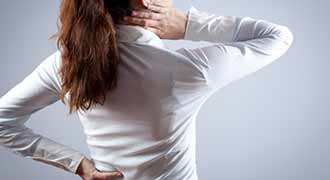 The back and neck are very complicated parts of the body, and can be severely injured by many different accidents and injuries. Some of these injuries occur naturally and can prevent individuals from working. Others can be caused by accidents or the negligence of others, and the injured person may be allowed to recover medical expenses or pain and suffering because of that injury. There are many different injuries that can affect the back and neck that can be caused by the negligence of another.
The back and neck are very complicated parts of the body, and can be severely injured by many different accidents and injuries. Some of these injuries occur naturally and can prevent individuals from working. Others can be caused by accidents or the negligence of others, and the injured person may be allowed to recover medical expenses or pain and suffering because of that injury. There are many different injuries that can affect the back and neck that can be caused by the negligence of another.
Diagnosis of Back and Neck Injuries
Diagnosis of these injuries will typically be done by any of the following methods (however, the list is certainly not exhaustive):
- Traditional X-ray
- CT or CAT scan
- MRI
- Spinal canal X-ray (myelogram)
Traumatic injuries such as falls or severe impact can cause herniated discs all through the back and neck.
Back Injuries
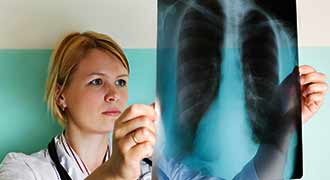
- Sprains and Strains: The back bears the majority of the body’s weight during walking, running, lifting, and other activities. Not surprisingly then, injuries to the back – such as sprains and strains – are common. Sprains are injuries to the fibrous tissue known as ligaments that connect two or more bones at a joint and prevent the excessive movement of that joint. Sprains occur when there has been a stretching or tearing of a ligament. Strains are injuries to muscles and the tough, fibrous tissue known as tendons that connect muscle to bone. Strains occur when a muscle or tendon has been pulled, twisted, or torn.
- Symptoms: pain that worsens with movement, swelling, bruising, muscle cramping or spasms, decreased function and/or range of motion, difficulty walking/bending forward/bending sideways/standing straight, experiencing a pop or tear at the time of injury
- Treatments: reduce pain and spasms with rest, ice packs, compression, and over-the-counter pain relievers…symptoms should improve in a couple of weeks; in more severe cases lasting beyond a couple of weeks, immobilization may be necessary using a brace or splint, and even surgical repair could be needed
- Disc Injury in the Back: Spinal disc herniation, sometimes known as a ruptured disc, is a medical condition affecting the spine due to trauma, among other causes, where a vertebral disc in the back bulges out beyond where it should. Spinal disc herniation most often occurs in the lumbar, or lower back region, and more rarely in the mid-back (thoracic region).
- Symptoms: pain that worsens with movement, swelling, bruising, muscle cramping or spasms, decreased function and/or range of motion, difficulty walking/bending forward/bending sideways/standing straight, experiencing a pop or tear at the time of injury
- Symptoms may affect the lower back, buttocks, thigh, anal/genital region, may radiate into the feet and/or toes, the hips and/or legs may also be affected
- Treatments: pain medication, cortisone shots (epidural steroid injections), rehabilitation, stretching, physical therapy, graduated exercise programs, and surgery as a last resort
Neck Injuries
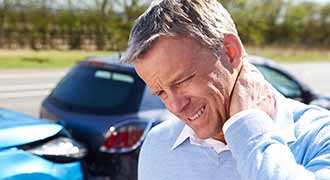 An article in the American Journal of Public Health revealed that occupants of vehicles that are rear-ended sustain neck injuries commonly known as whiplash. In fact, whiplash is one of the most common nonfatal motor vehicle accident injuries. Approximately 85% of all neck injuries seen by doctors are the result of automobile crashes; and of those injuries due to car accidents, 85% resulted from rear-end collisions. The other 15% of neck injuries sustained in crashes resulted from some point of impact other than the rear of the vehicle (i). In light of the nearly 4 million rear-end auto accidents in the U.S. annually, whiplash injuries have become a major public health problem.
An article in the American Journal of Public Health revealed that occupants of vehicles that are rear-ended sustain neck injuries commonly known as whiplash. In fact, whiplash is one of the most common nonfatal motor vehicle accident injuries. Approximately 85% of all neck injuries seen by doctors are the result of automobile crashes; and of those injuries due to car accidents, 85% resulted from rear-end collisions. The other 15% of neck injuries sustained in crashes resulted from some point of impact other than the rear of the vehicle (i). In light of the nearly 4 million rear-end auto accidents in the U.S. annually, whiplash injuries have become a major public health problem.
- Whiplash (Soft Tissue Injuries) – Whiplash is an injury that affects the soft tissues of the neck, occurring as the result of a sudden jerking or “whipping” of the head. This jerking or whipping motion strains the ligaments and muscles in the neck beyond their typical range of motion. The condition can be mild and cause pain for only a few days, or more severe disability like restricted head movement accompanied by persistent pain.
- Symptoms: pain/aching in the neck, headaches, dizziness, blurred vision, fatigue, difficulty concentrating, memory problems, ringing in the ears, sleep troubles, irritability, pain spreading to the shoulders, pins and needles in the arms/legs (**Note: Whiplash symptoms typically arise within the 24-hour period immediately following the occurrence of the injury)
- Treatments: rest, over-the-counter pain relievers, prescription pain relievers, applying ice and/or heat to the area of painful neck muscles, physical therapy, numbing injections, muscle relaxers, wearing a foam cervical collar for neck stability, range of motion exercises
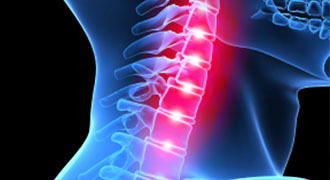 Disc Injury in the Neck: The second most common site of spinal disc herniation is the neck, also known as the cervical region.
Disc Injury in the Neck: The second most common site of spinal disc herniation is the neck, also known as the cervical region.
- Symptoms: pain ranging from very little to severe and unrelenting, numbness, tingling, weak muscles, paralysis
- Symptoms can affect the back of the skull, the neck, shoulder girdle, shoulder blade, shoulder, arm, and hand; nerves of the neck, arm, and hand can all be affected as well
- Treatments: medication to manage pain, cortisone shots, stretching, rehabilitation, physical therapy, graduated exercise programs, and ultimately surgery if all else fails
Spinal Cord
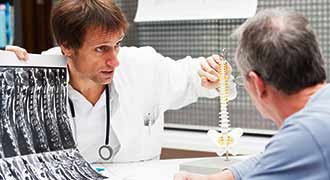 Spinal injuries can occur in all regions of the back from lower (lumbar spine) to mid-back (thoracic spine) to up in the neck (cervical spine). These injuries can result from car accidents, slip and falls, or any number of other causes. There are many kinds of injuries that can be sustained, including: dislocation of part of the spine, compression of part of the spine, or even damage to the bending of the spine.
Spinal injuries can occur in all regions of the back from lower (lumbar spine) to mid-back (thoracic spine) to up in the neck (cervical spine). These injuries can result from car accidents, slip and falls, or any number of other causes. There are many kinds of injuries that can be sustained, including: dislocation of part of the spine, compression of part of the spine, or even damage to the bending of the spine.
Learn More…
Prevention of Neck and Back Injuries
- Exercise – particularly core strengthening to help with stabilization and support
- Maintain good posture – this will reduce pressure and keep your back straight and aligned
- Lift heavy objects properly – with your legs, not your back, doing most of the work
- Maintain a healthy weight – the heavier you are, the more pressure on your body, putting it at greater risk for injury
Have You or a Loved One Been Injured Through the Fault of Another?
 If you or a loved one has been injured through the fault of another, you may want to speak with a personal injury attorney regarding a potential claim. d’Oliveira & Associates has over 30 years of experience handling personal injury claims in Rhode Island and Southeastern Massachusetts and works with other attorneys in most states around the country.
If you or a loved one has been injured through the fault of another, you may want to speak with a personal injury attorney regarding a potential claim. d’Oliveira & Associates has over 30 years of experience handling personal injury claims in Rhode Island and Southeastern Massachusetts and works with other attorneys in most states around the country.
Call d’Oliveira & Associates at 1-800-992-6878 or fill out an online contact form for a free consultation.
Sources:
- (i) American Journal of Public Health. 1972.
(http://ajph.aphapublications.org/doi/pdf/10.2105/AJPH.62.3.399)
